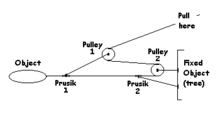Z-drag

A Z-Drag is an arrangement of lines and pulleys commonly used in rescue situations. The basic arrangement provides a theoretical mechanical advantage of three.[1][2] The name comes from the fact that the arrangement of lines is roughly Z shaped. Besides the mechanical advantage to pulling, it also uses only part of the total length of the rope for the block and tackle arrangement.
The typical configuration (shown below) uses two single pulleys and two Prusik knot loops or other suitable friction hitches.[1] The first Prusik knot provides the mechanical advantage. The second Prusik knot can be used to hold the position of the rope and is sometimes referred to as a 'progress capture device' or ratchet. It is also advisable to attach a towel or soft object (such as a life vest) to the end of the line near the connection to the object being pulled since the line is under high tension and could break free and present a dangerous flying hazard.
Borrowed from rock climbing, the Z-Drag is considered an important tool in whitewater rescue and is used primarily for the recovery of pinned boats.[1]
The Z-Drag is considered an important tool in mountain rescue because of its simplicity and is used for nearly all lifting systems.
It also serves as an excellent method for tightening the rope to be crossed in a Tyrolean traverse, where the other end is also fixed to a stable object.
See also
- Trucker's hitch - another 3-fold advantage system using single loops
- Mechanical advantage
References
- Swiftwater Rescue: A Manual for the Rescue Professional ISBN 978-0-9649585-0-0
- Whitewater Rescue Manual: New Techniques for Canoeists, Kayakers, and Rafters ISBN 978-0-07-067790-6
- River Rescue: A Manual for Whitewater Safety ISBN 978-1-878239-55-6
- Swiftwater Rescue ISBN 978-0-9830683-0-3